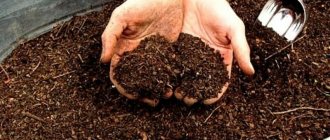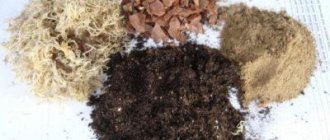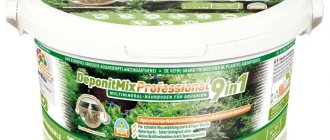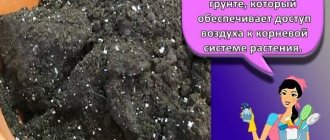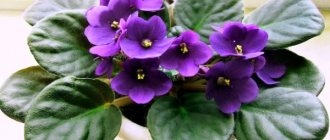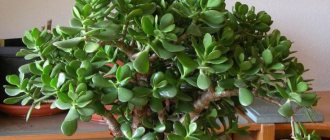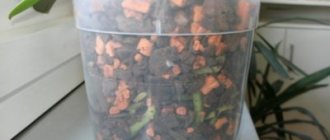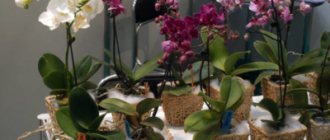Phalaenopsis are predominantly epiphytic orchids that prefer to live in trees rather than on the ground. This feature requires an extremely careful approach to the choice of substrate. It is necessary to understand that even a minor mistake made during the manufacturing process can lead to the most dire consequences.
In the article we will tell you in detail what kind of soil is needed for the phalaenopsis orchid for its healthy development. You will also learn how to choose the right soil mixture in the store or make it yourself using our step-by-step instructions and videos.
The importance of an unmistakably composed substrate: can it be planted in the ground?
The soil for the flower in question serves, first of all, as a support. For this reason, it is subject to special requirements regarding looseness, moisture absorption and breathability.
Phalaenopsis is unlikely to live long in ordinary soil. First of all, its roots, which take an active part in photosynthesis, will rot. Following this, the upper part of the plant will begin to fade. Accordingly, phalaenopsis will definitely not be able to bloom in the wrong substrate.
The nuance is that the root system needs light no less than the leaves. Ordinary land cannot provide this.
Look at any photo of an orchid growing at home in a transparent pot, and you will understand why a regular soil mixture will not work for it.
What kind of soil does an orchid need?
First of all, you need to understand that the substrate is not just the raw material that contains the flower. Its composition, in terms of importance, is on a par with lighting, fertilizer and watering. The market for related products for gardening at home is very wide. On store shelves there are various substrates for orchids from European or domestic manufacturers.
The abundance of assortment leads to the appearance of fakes. A low-quality substrate can destroy the plant. Preparing the soil with your own hands is not entirely advisable. No matter what skills you have, you will not be able to find quality raw materials. The following substrate characteristics are important for an orchid:
- breathability;
- moisture capacity;
- acidity;
- nutritional value;
- no toxic emissions;
- slow decomposition process.
The roots of a flower must breathe, which means choose a less dense material that will not block the access of oxygen. Pay attention to how the raw material absorbs water. The plant needs a minimum amount of moisture. Errors in soil selection lead to disastrous consequences. If you start the destruction process with your own hands, you will not be able to reverse it. This is why it is recommended to buy ready-made substrates.
The habitat determines how the flower will grow, the number of flowers, their size, and survival rate. Most indoor dwellers get their nutrients from the soil. Through the root system, microelements reach all above-ground parts. Proper transportation will occur if comfortable conditions are created for the absorption of fertilizers.
Unlike garden flowers, home inhabitants are accustomed to artificial conditions. They will not be able to constantly adapt to changes in temperature, humidity and other weather factors. They are more comfortable in stable, human-controlled environments. In other words, care lies entirely on the shoulders of the owner and this is convenient for the plants.
Organic raw materials are capable of releasing nutrients up to a certain point. When supplies run out, you need to replenish them with synthetic products. No matter how rich the substrate is, when it reacts with water and roots, it is depleted
What soil composition is needed for a phalaenopsis orchid?
It must be emphasized that phalaenopsis cannot be planted in a substrate where there is soil. If you come across such a mixture in a store, then draw the right conclusions and do not purchase any more products from this brand.
The situation, however, is quite possible to improve. Simply pour the contents of the bag into a bucket of water and use only the ingredients that float to the top.
The soil intended for phalaenopsis varies in composition. However, the main ingredient is almost always pine bark. Strictly speaking, it is not an ideal solution, but it is excellent for growing representatives of the Orchid family at home. The material, on the one hand, ensures uniform distribution of water, and on the other, allows air to penetrate to the roots.
If you collected the bark yourself, be sure to sterilize it by boiling. This will kill pests, bacteria and reduce resin content. It is important to get rid of the latter, as it greatly reduces moisture capacity.
Oak bark is used a little less frequently. Its properties fully correspond to those of pine. But tannins can create a problem here. They can also be removed by boiling.
Peat is taken from the top. Its advantage is high moisture capacity. The component adsorbs nutrients and gradually releases them to the orchid. The disadvantage of the material is high acidity. The indicator is normalized by mixing dolomite flour (1 tbsp per kg).
Coconut fiber is used as a substitute for peat and sphagnum moss. It does not cake, absorbs water well, and does not interfere with air circulation. It is mainly taken when phalaenopsis is planted in blocks.
Vermiculite loosens the soil mixture and slows it down:
- drying out;
- compaction;
- salinization
Sphagnum moss is uniquely hygroscopic. It is able to absorb moisture even from the air, which is very valuable for phalaenopsis. It is also a supplier of a number of useful minerals.
Charcoal is mixed into substrates in limited quantities (no more than 5%). Its purpose is to enhance air permeability and moisture capacity. There is another advantage - antiseptic properties.
Pine cones are sometimes recommended for use as a substrate, but this should only be done in extreme cases. The problem is that they contain a lot of resin, which cannot be removed by boiling.
Important: humus or leaf soil can be placed in the soil for phalaenopsis, but in very small quantities. They must be steamed first.
To grow a healthy orchid, you will also need drainage. Most often used:
- expanded clay;
- Styrofoam;
- small crushed stone;
- broken ceramics.
These components are placed strictly on the bottom of the pot, but sometimes some of them are included in the substrate.
Soils for garden plants GEOLIA reviews
Verified Purchase Review:
In some pots some strange plants of unknown origin sprouted. Previously, this happened with a coconut briquette, Mimosa pudica grew in it, I’ll wait for the sake of interest, I won’t pull out these “emigrants”,
Geolia Premium “Universal” soil 25 l
Name:
Sergey
Review:
Soil is not particularly expensive.
Money down the drain. Advantages:
none
Disadvantages:
The soil is contaminated with fungus, the fungus cannot be removed by anything. To be thrown away.
Name:
Victoria
Review:
excellent quality.
There are no pests, the soil is simply wonderful. I will buy it again and recommend it to everyone. You will be very pleased. Pros:
excellent quality.
Disadvantages:
none identified yet.
Name:
Love
Review:
I constantly buy this soil for my indoor flowers and flower beds in the yard, everything takes root, no pests, I’m very happy!!
Advantages:
Loose, nutritious
Disadvantages:
None
Name:
Elizaveta
Review:
I bought this soil for seedlings.
The soil composition is excellent! The presence of sand in the soil gives fluffiness, which is important for the germination of fragile seeds. The soil is very rich, the seeds sprouted ahead of schedule. It is also important that the soil does not harden and does not form a top crust. There are lumps, but they break easily. I will continue to use this soil. Advantages:
Fluffy, fertile, inexpensive.
Disadvantages:
Small flies and their larvae (I baked them in the oven for an hour to solve this problem).
Name:
Alina
Review:
I bought soil for indoor plants.
Lightweight, porous, allows moisture to pass through very well when watered, does not harden, and fits close to the edge of the pot. The color of the soil does not change. I found no pests. There are no foreign objects (rhizomes, pebbles, etc.). The description states that it contains nutrients for 3 months and is not worth fertilizing, but I recommend fertilizing after a month. And so the flowers took root well. I recommend this product. Advantages:
Loose, pest-free
Disadvantages:
It is still better to feed the plants additionally,
Geolia soil “For seedlings” 10 l
Name:
Oleg
Review:
Bought for seedlings. Everything has sprouted. High-quality seedlings have grown.
Advantages:
High-quality No need to add anything (sand and fertilizer are present)
Name:
Azada Employee Lm
Review:
soft loose soil with grains of perlite, seedlings grow very well even without fertilizing.
I recommend it. Advantages:
excellent soil
Disadvantages:
none
Name:
Victoria
Review:
Very good! I recommend
Advantages:
I really liked the soil! Light, fluffy without sticks. Seedlings sprout well
Disadvantages:
none
Name:
Ekaterina Kryazhevskikh, Employee
Review:
Excellent soil.
It contains all the components for successful seedlings. No wonder it's premium! Advantages:
Nutritious, there are beneficial bacteria that protect against diseases, as well as hydrogel, vermiculite.
It doesn't track! Plant it and everything will be ok! Disadvantages:
no
Name:
Elena
Review:
Excellent soil. Loose, fatty, light. Good water permeability.
Name:
Irina
Review:
Good soil, I recommend it!
Advantages:
Good soil, no debris, light and crumbly, white grains of perlite are visible, I liked it, judging by the state of the seedlings, so did the growers!
Disadvantages:
Not found
Name:
Anastasia
Review:
At the end of February, I planted two tomatoes in this soil and one tomato in the “Botanist's Dream” seedling soil.
So: today the two tomatoes that grew in the “Botanist’s Dream” look barely alive (3 cm high). The same cannot be said about the tomato that grew in Geolia, five times taller and stronger. Advantages:
Clean soil, crumbly.
Seedlings grow well in it. Disadvantages:
A little expensive. I bought it in February for 88 rubles (10 liters).
Geolia primer “For decorative deciduous trees” 10 l
Name:
Elena
Review:
Not a bad soil for replanting indoor flowers.
Pros:
Dense. More like soil than a peat mixture.
Disadvantages:
I would like to see other volumes of packaging. Sometimes you just don’t need the same quantity and vice versa.
Name:
Madina Employee Leroy Merlin
Review:
It has an optimal pH level for growing various crops, which promotes rapid growth, health and proper development of plants.
Advantages:
Airy, enriched with minerals, does not require additional fertilizers for 2-3 months.
Disadvantages:
not identified
Name:
Anton
Review:
In general, I like Geolia, but this particular soil disappointed me because of the presence of a decent number of sticks in the package.
I took a premium of the same brand, there was no such problem... I don’t know, maybe there was a defect... Advantages:
Inexpensive
Disadvantages:
Availability of poles
Name:
Natasha
Review:
My ficus plants have grown. It’s time to transplant them into larger pots. I bought this soil and couldn’t be happier. When watering, the water does not rise up, like in others, it is absorbed evenly. The plants are comfortable. The most important thing is that you don’t need to spend money on fertilizers. The soil contains a supply of nutrients for half a year.
Advantages:
Inexpensive, good composition
Disadvantages:
none identified
Name:
Ksenia
Review:
I bought Geolia by accident for the first time.
If you don’t have the time or opportunity to mix different soils for different plants each time, then this is an excellent solution. Advantages:
the only worthy ready-made soil! There are no parasites in it, unlike some others. really almost universal.,
Geolia Premium “Universal” primer 5 l
Name:
Leonid
Review:
Very good soil. I always buy only this soil. For seedlings and replanting home flowers.
Advantages:
Good balance of additives. Several types of packaging (by weight).
Disadvantages:
I think there are no disadvantages.
Name:
Irina
Review:
Good soil, I use it for seedlings and indoor plants, I just add a little more perlite.
For the fatty plus, I added zeolite. Coriander generally feels great, as does lemon balm. Of the minuses: in one package there was a stick of 15 centimeters... Advantages:
seeds sprout quickly, fairly loose soil, good composition
Disadvantages:
mold may appear if there is excess moisture on the surface, sticks come across
Name:
Ivan
Review:
The soil is relatively inexpensive, loose and nutritious, but it gets moldy. It’s the soil, not the additives, because we’re buying it a second time and the situation is the same. Advantages
:
Price, looseness.
Disadvantages:
Mold.
Name:
Maria
Review:
A neighbor recommended this particular soil. She is an experienced summer resident. We are satisfied.
Advantages:
Good soil. We plant seedlings only in it for the second year. Everything grows by leaps and bounds.
Disadvantages:
none
Name:
Denis
Review:
Excellent soil, used for bushy trees. Mixed the soil with coconut, 15% perlite-vermiculite, 15% sand in a 10 liter bucket, grows without problems, poured it with plain water for a couple of months, then fertilizer.
Advantages:
5+ price-quality
Disadvantages:
the main thing is to mix the soil correctly, then there will be no problems.,
Geolia Premium “Universal” soil 50 l
Name:
Marina
Review:
I bought it for seedlings in the spring.
Everything went well. Advantages:
Fat, good soil
Name:
Irina
Review:
I bought it for my mother.
She was pleased. Almost everything that was planted has sprouted) we rejoice in fresh vegetables!!! Advantages:
Large volume.
Can be used for any seedlings. Disadvantages:
No cons
Name:
Marina
Review:
stone soil..
Advantages:
the composition seems to be quite good.
Disadvantages:
half a bag (50 l) was in large, heavily pressed lumps of large sizes (It was very difficult to break them with a shovel and it took a long time. Loosening them with hands or blows is useless - the feeling of stone. nothing I can’t say anything good... I’ve suffered... how living green friends will grow in it - time will tell)))
Name:
Tatyana T Leroy employee Merlin Sholokhovo
Review:
The soil is good for preparing a mixture of various soils.
Contains a lot of sand and perlite (12% of the total mass). The soil is very loose. It smells like humus. Black color. In its pure form it will not dry into a lump or an impenetrable crust. Advantages:
Large percentage of sand and perlite.
The composition of microelements is indicated in some detail. There is no chemical smell. There is no debris, sticks, stones or clods. Good pH level. Low price. Disadvantages:
The NPK composition of this soil is not very nutritious; it requires additional fertilizer for growing seedlings.,
Geolia soil “Flower” 5 l
Name:
Tatyana
Review:
Very high quality soil!
Advantages:
Does not require dilution, very pleasant to work with, does not clump, does not dry out, the best soil for flowers in this price segment
Name:
Galina
Review:
The bag contains not 5 declared liters, but only 4 liters! Otherwise the soil is quite normal.
Name:
Tatyana
Review:
Good soil.
Advantages:
Does not lag behind the pot, flowers grow well.
Name:
Ekaterina
Review:
Very good soft, quite dense in structure
Advantages:
Quality
Name:
Alexandra
Verified Purchase Review:
Flowers are still alive
Name:
Irina.
Leroy employee Merlin Kazan1. Review:
After two weeks, my orchid sprouted a new sprout.
Pros:
I am very pleased with the soil.
Packed very well, moderately moistened, the bag of coal is sealed separately from the bulk of the soil. Disadvantages:
In my opinion, the oak bark itself is a little large. Therefore, before planting the plant, I crushed it a little extra.
Name:
Emma
Review:
Good soil and not expensive
Advantages:
Lightweight, composition
Disadvantages:
No,
Geolia primer “Universal” 25 l
Name:
Julia
Review:
I buy it all the time for flowers, garden plants and seedlings.
High-quality and fertile soil without debris. Advantages:
Excellent soil, no debris
Disadvantages:
None
Name:
Victoria
Review:
Well suited for seedlings. Doesn't rot
Name:
Dmitry, Employee of the Leroy Merlin Store Lyubertsy
Review:
I recommend for purchase, I will buy it again for replanting flowers
Advantages:
good price, 25 liters are enough for several pots
Disadvantages:
none observed
Name:
Evgeniy
Review:
Excellent soil for seedlings, seedlings, and for planting crops in place.
A complex of mineral fertilizers has been added to the soil. Advantages:
Decent soil in its price category.
Disadvantages:
None identified in 2 years.
Name:
Marina, Leroy Merlin employee
Review:
good soil, suitable for flowers, vegetables and other plants.
everything has sprouted Advantages:
different packaging of goods
Disadvantages:
not identified
Name:
Marina, Leroy Merlin Employee
Review:
universal primer, suitable for flowers and seedlings.
everything has sprouted Advantages:
convenient packaging,
Geolia soil “Flower” 25 l
Name:
Julia
Review:
I really liked this peat soil!
My mother and I tried a lot of different types of soil. This one was singled out as the best! The flowers take root well and take root after transplantation. No complaints at all! The flowers love this soil and we are happy! Advantages:
- Quality - Price
Disadvantages:
- None
Name:
Olga
Review:
Excellent peat soil.
The best one I've used for the last 5 years. Geranium cuttings and plants take root with a bang. After transplanting petunias, buds appear one after another. The fuchsias immediately began to grow leaf mass and lay buds. Buy, plant and enjoy healthy and beautifully flowering plants. Advantages:
light, fluffy, does not compact after watering.
Balanced composition of macro and microelements. Peat - the soil is well sifted. Disadvantages:
None.,
Geolia primer “Universal” 50 l
Name:
Julia Employee of Leroy Merlin Orbital
Review:
I use this soil for Snails, this package lasts me for 2.5 years.
Satisfied with the quality Advantages:
Price, Quality
Disadvantages:
none identified
Name:
Dmitry
Review:
I recommend
Advantages:
quality
Disadvantages:
the volume is large and when you buy it you need a car or delivery. You can't carry it by hand.
Store soil
The easiest way to provide acceptable conditions for orchids is to use store-bought soil mixtures. Let's tell you more about them.
What should be included
Ready-made substrates typically contain the following ingredients:
- pine bark;
- wood chips;
- charcoal lumps;
- peat;
- sphagnum moss.
Soil for phalaenopsis must be sterilized and packaged in plastic bags or buckets with a capacity of 1 to 5 liters.
Definition of quality
A good composition contains mainly bark - its fraction is small, from 10 to 30 mm. The pieces should remain strong. If they fall apart in your hands, then this is considered a marriage.
Charcoal is taken of medium size (up to 20 mm). He should also be hard and unbreakable.
Moss is used exclusively dry - it is present in the form of small shreds.
A substrate of proper quality is generally crumbly, does not form a lump when compressed, and never contains inclusions with traces of mold.
The smell of dampness is also unacceptable - if there is one, then planting an orchid in such soil is simply dangerous.
How to choose
Not all store-bought mixtures will allow you to grow healthy phalaenopsis, so be very responsible when purchasing them.
First of all, make sure that the soil is intended specifically for orchids - this is indicated by a special mark.
Next, read the list of ingredients - it is advisable that it coincides as much as possible with the above.
Check the container for leaks. The substrate is sterilized, and therefore even a small hole in the packaging can lead to infection by bacteria and pests.
The presence of fertilizers in the mixture is not mandatory. The mineral-enriched option is more suitable for young plants.
Important: if polystyrene foam is included in the substrate, there is nothing wrong with that, but its presence does not eliminate the need to put a drainage layer in the pot.
Choosing the best: purchased options
When deciding which soil is best to buy for a phalaenopsis orchid, many experience difficulties. This is not surprising, because the assortment in stores is very large. However, there are several well-established manufacturers that you can give preference to.
“Garden of Miracles” is a purely Russian finished product, produced for many years by Fart. It is versatile and suitable for many types of orchids, including phalaenopsis. The soil is sold in 2.5 liter bags. For one unit you will have to pay only 95 rubles.
“Flower happiness”, in principle, is ideal for indoor epiphytes, but has one drawback - the substrate contains larch bark. You will have to add pine yourself - this is a direct recommendation from the manufacturer. The price of the mixture, however, is low - just over 70 rubles for 2.5 liters.
Judging by the reviews, the soil called Peter Peat is very good. It is highly nutritious and allows you to confidently grow most epiphytic orchids. The ingredients included in it ensure proper breathability and moisture retention. The optimal choice for transplantation. It is very inexpensive - 50 rubles for 2.5 liters.
Pokon (“Pokon”) is another high-quality ready-made substrate. On the one hand, it does not allow water to stagnate, and on the other, it does not block air access to the orchid’s root system. The manufacturer himself emphasizes that his product contains only natural ingredients:
- top quality bark;
- lime;
- complex feeding.
The volume of the latter is sufficient so that the plant does not need additional fertilizer over the next 2 months. The only disadvantage of soil should be considered its high price. For 2.5 liters you will need to pay approximately 650 rubles.
Compo Sana (“Compo Sana”) is another very expensive German substrate. The soil mainly contains high-moor peat and bark. Auxiliary ingredients are as follows:
- lime;
- minerals.
Many users find that this mixture cannot be considered ready for use due to its high peat content. It is recommended to mix it with homemade soil in a ratio of 1 to 3. The price of 5 liters is approximately 380 rubles.
Probably the best choice in our country is Effect Bio. This substrate ideally combines reasonable price and high quality. The finished mixture is clean and dry.
In addition to Angora pine bark, it contains:
- sphagnum;
- vermicompost.
The environmental friendliness of the soil is confirmed by a certificate of conformity, and therefore it is suitable for most epiphytic orchids. The substrate is suitable for transplanting, growing young orchids and even children. A 2-liter bag will cost 300 rubles.
This, of course, is not a complete review, and therefore, if you come across an unfamiliar brand of soil for phalaenopsis, be sure to read the reviews about it.
